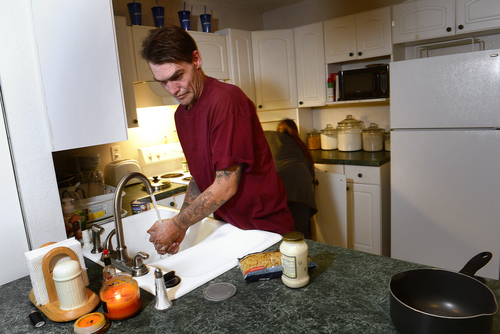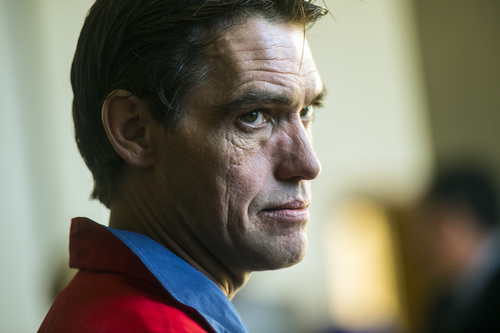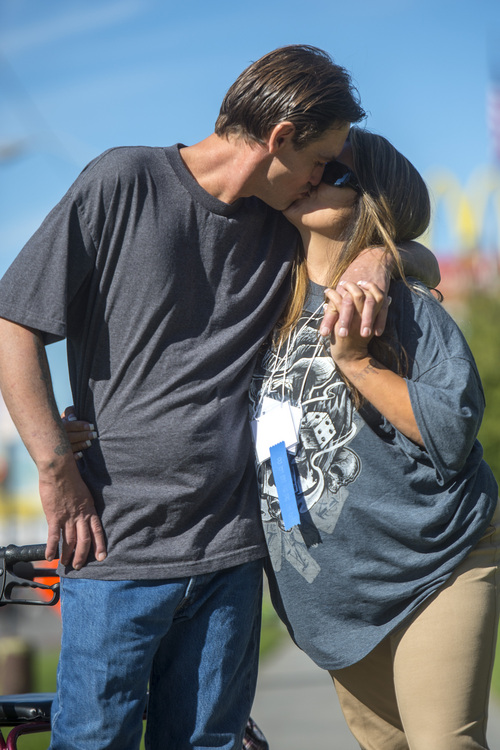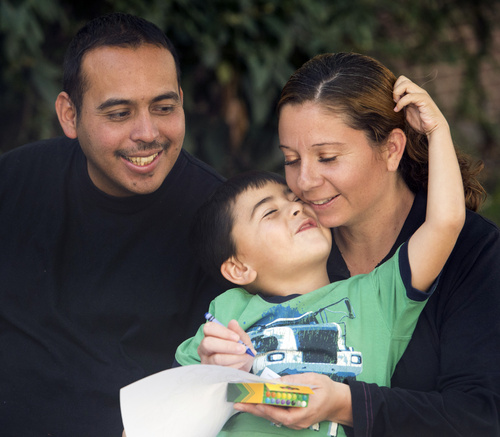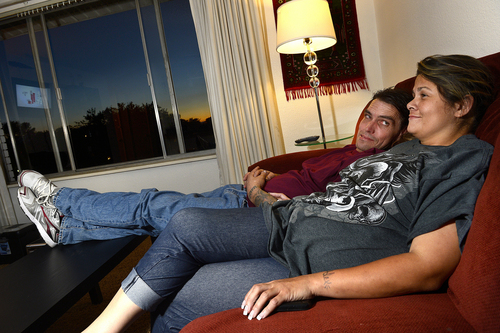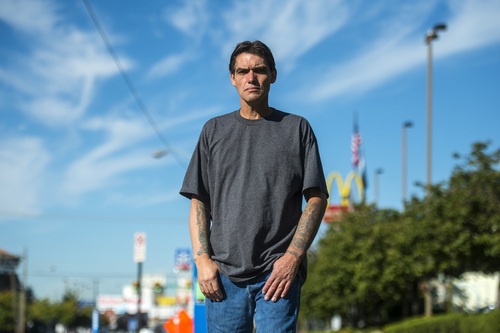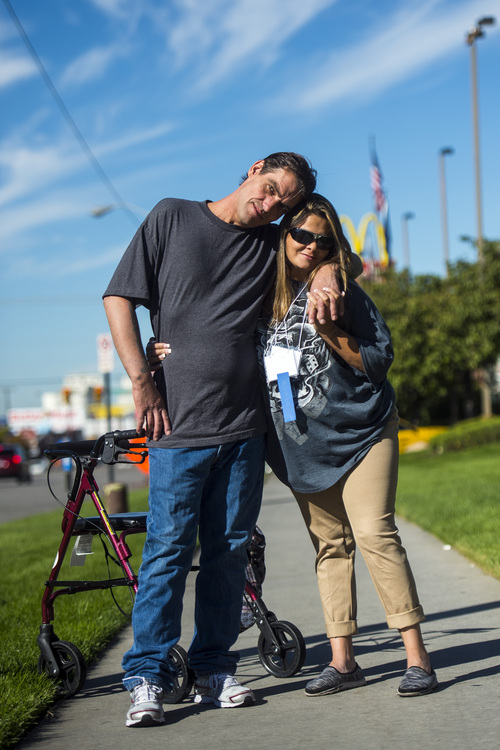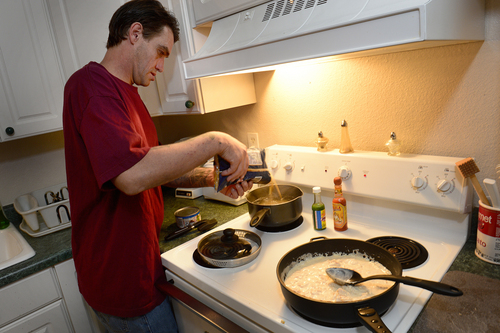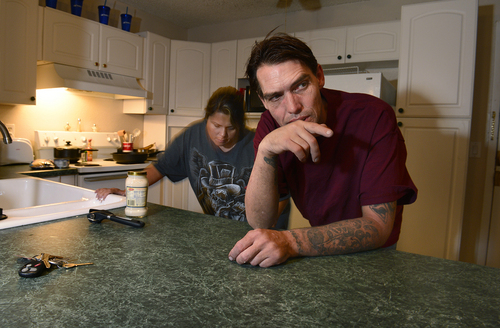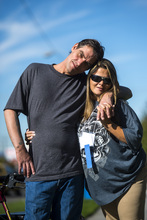This is an archived article that was published on sltrib.com in 2014, and information in the article may be outdated. It is provided only for personal research purposes and may not be reprinted.
When Joseph Hardy and his three siblings were young, his mother took them from his polygamist father and bolted.
They spent the next decade on the run — camping in the summers, crashing with friends when they could, and grabbing an inexpensive rental when the money held out.
"I feel like I grew up in the back seat of a car," Hardy says today.
At age 15, he began using methamphetamine to dull his grief and anxiety. Drug use and depression have ravaged his health, and he's spent about 14 years of his life behind bars.
But the last time he was arrested, Hardy was offered a new choice: treatment and his own apartment, with support from a caseworker to help him shape a new life.
Hardy qualified for Utah's Housing First initiative to help the chronically homeless — those who haven't had a place to live for a year, or have been without housing four times over three years.
The long-term homeless were once told they had to beat their addictions and find jobs to get and keep housing. But by embracing the Housing First model, Utah has reduced its chronically homeless population from 1,932 to 539 — a drop of 72 percent since 2005.
Keeping a promise made 10 years ago this week, the Utah Homeless Task Force expects to have effectively ended chronic homelessness in the state by the end of 2015.
"We now have a system that can deal with these kinds of situations," said Lloyd Pendelton, the director of the Utah Homeless Task Force. "It effectively and efficiently moves people into new opportunities."
Key to the effort's success is the argument that Housing First saves taxpayers money. While the chronically homeless make up a fraction of Utah's overall homeless population, they consume a disproportionate amount of resources.
—
The campaign • Hundreds of cities across the country drafted 10-year plans to end chronic homelessness under an initiative launched by President George W. Bush. The Obama administration has set national goals of ending veteran homelessness by the end of 2015, chronic homelessness by 2016 and family and youth homelessness by 2020.
Utah stands out — and is drawing national attention — for its statewide approach.
Utah says it already has eliminated veteran homelessness — having moved hundreds into housing with units waiting for those who want to leave the streets.
The federal government still is deciding what will amount to "ending" chronic homelessness, although advocates expect the definition to be similar.
Utah's Housing First initiative, spearheaded by the state Division of Housing and Community Development, got underway in April 2005 and includes participants such as Volunteers of America and Valley Mental Health, the 4th Street Cliinic and The Road Home.
With federal, state and local funds, service providers, both public and private, have built new projects and found homes in existing projects for some 1,400 chronically homeless people.
In many ways, Hardy, now 45, fits the profile Utah is targeting: He was separated from his family, he suffers from mental illness and has a drug addiction.
His life got off to a rough start in southern Utah. His father was affiliated with the Fundamentalist Church of Jesus Christ of Latter-day Saints and had 28 children with many wives.
His disjointed youth led him to drugs and, over the years, he has intravenously used any number of illicit substances.
"I started doing things that were immoral ... I was a slave to my addiction," he said. "I've destroyed every relationship."
Along the way, he has fathered three children. One died in an accidental shooting and he doesn't know who the two others are or where they might be found.
In 1995, Hardy contracted hepatitis B and C. He remembers falling into a deep depression and shooting up a large dose of heroin before walking down to a Salt Lake City rail yard. In a suicide attempt, he jumped between two moving train cars.
He survived, but the attempt almost tore off his leg, he said, pulling up his pant leg to display scars from his knee down.
—
The turnaround • Fourteen months ago Hardy was arrested again. He spent three months in jail, where he underwent drug counseling and signed on to a program that offered treatment and probation rather than incarceration.
In November, he went into in-patient housing with Valley Mental Health for mental health and substance abuse counseling.
And in April, Hardy was placed in an apartment through the Housing First program.
He has been sober for more than a year. He says he is learning again what it's like to have feelings that are not the product of substance abuse.
He has a new girlfriend. He wants to find his surviving children and other people who were walled off by his addiction. He is in touch with his mother and two sisters, but not his brother, who was imprisoned in California for statutory rape.
Hardy feels better now than he has in a long time. His health has improved markedly — his ailing liver has begun to function normally.
"I want to live," he said.
The cost for housing Hardy is about $7,000 to $8,000 a year, according to the Utah Homeless Task Force. Under the program, he must pay 30 percent of his income or $50 per month, whichever is higher.
Pendleton, the task force director, said the Housing First program saves taxpayers about $12,000 per year in service costs for every chronically homeless person moved into housing. On average, each chronically homeless person racks up about $20,000 in emergency services, but in some cases, it's much more.
Treating patients who have a permanent address is much more cost-effective than administering health care to people on the street, said Jennifer Hyvonen, spokeswoman for the 4th Street Clinic.
But it's not an apples to apples comparison, because patients with housing get regular and thorough health care, unlike the homeless, who often are treated only when faced with serious health threats.
"Housing is the number one thing you can do for (better) health care," she said. "If you don't have housing, you're in a constant state of crisis — overall health falls by the wayside."
During the past decade, the clinic's budget has doubled, Hyvonen said. It now offers a host of services, including dental care, mental health and substance abuse programs.
—
'I wouldn't be here' • The savings claimed by the state of Utah and other Housing First programs are difficult to measure, said James Wood, director of the University of Utah's Bureau of Economic and Business Research. It's a challenge to calculate the costs of services offered to people when they're living on the street, he said.
Wood and his team followed Utah's first 17 clients of Housing First for two years beginning in 2005. Twelve remained in the program at the end of 24 months: one died, one disappeared, and three withdrew.
For many service providers, there was a reduction in costs, Wood said. But the expense of hospitalization and housing construction costs can throw a wrench into averages, he explained.
Hardy is grateful for his own fresh start, which he described at the 2014 Homeless Summit last week in Salt Lake City.
"I'd like to thank the Road Home," Hardy told an appreciative audience. "If it weren't for them and the 4th Street Clinic, I wouldn't be here today."
Still, even with housing and excellent medical care, Hardy struggles financially as he picks up odd jobs. He is a trained auto mechanic, but his injured leg and mental health issues keep him from holding down a full-time job.
So far, he has not been able to qualify for Social Security disability payments. The financial insecurity does nothing to quell his anxiety.
Wood and other observers of the chronically homeless believe their lots are cast as teenagers or young adults when they begin to fall away from sustainable lifestyles.
Hardy agrees. He told the Homeless Summit audience that incarceration costs about $35,000 a year per person.
"How much taxpayer money has it cost to lock me up (for 14 years), instead of spending a lot less when I was young," he said. "We can't go back, but we can change the future."
csmart@sltrib.com —
Trib Talk: Battling homelessness
O 12:15 p.m. Monday • Utah has spent the past 10 years fighting chronic homelessness and experts say the state has effectively won that battle. Still, every year thousands of individuals and families facing economic instability wind up on the street. Advocate Pamela Atkinson, Lloyd Pendleton of the Utah Homeless Task Force and Tribune reporter Christopher Smart join Jennifer Napier-Pearce to talk about the "Housing First" strategy and the next phase in getting more people out of shelters. Watch this video chat at sltrib.com. You can also join the discussion by sending questions and comments to #TribTalk on Twitter and Google+ or texting 801-609-8059.


